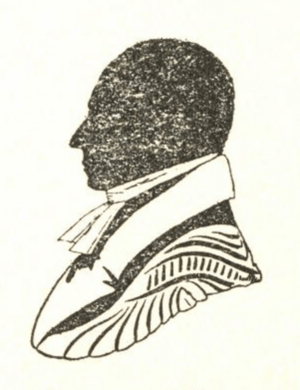Raid on Charlottetown (1775) facts for kids
Quick facts for kids Raid on Charlottetown (1775) |
|||||||
|---|---|---|---|---|---|---|---|
| Part of the American Revolutionary War | |||||||
 Rev. Theophilus Desbrisay, taken prisoner |
|||||||
|
|||||||
| Belligerents | |||||||
| Commanders and leaders | |||||||
| Strength | |||||||
| 2 brigs | militia | ||||||
The Raid on Charlottetown happened on November 17–18, 1775. This event took place early in the American Revolutionary War. Two American privateers attacked and robbed Charlottetown, Prince Edward Island. At that time, Prince Edward Island was known as St. John's Island.
A privateer is like a private ship that has permission from its government to attack enemy ships. After the raid, the governor of Nova Scotia, Francis Legge, declared martial law. This meant the military took control. Even though the raid was successful, George Washington quickly set free the important officials the privateers had captured. They were taken as prisoners to Cambridge, Massachusetts.
Why the Raid Happened
During the American Revolution, American ships often attacked Nova Scotia. These attacks hurt the economy of the area. They raided towns like Liverpool and Annapolis Royal.
In October 1775, British forces burned a town called Falmouth, which is now Portland, Maine. To get back at them, General Washington decided to use two ships for privateering. These ships were from John Glover's Marblehead Regiment.
Captain Nicholson Broughton commanded one ship, the Hancock. Captain John Selman (privateer) commanded the other, the Franklin. They were told to stop two British ships carrying weapons. These ships were heading to the St. Lawrence River from England.
But Broughton and Selman decided not to follow these orders. They thought it was too risky. Instead, they looked for easier targets near Cape Canso. They captured five ships there. They also heard that the British were recruiting soldiers on St. John's Island. So, they decided to attack it.
The Attack on Charlottetown
On November 17, Captain Selman and Captain Broughton landed in Charlottetown. They each led a small group of six men. They captured two important people: Acting Governor Phillips Callbeck and Surveyor General Thomas Wright. They hoped to trade these prisoners for American soldiers captured by the British.
The privateers searched Callbeck's home and took his supplies. They also took the colony's silver seal and important papers. They robbed Governor Patterson's house too.
Selman and Broughton also looked for the wives of Callbeck and Captain David Higgins. Both women were daughters of important loyalists from Boston. Loyalists were people who supported the British king. The privateers did not find them.
Before leaving, the privateers made the cannons at the fort useless. This is called "spiking" the cannons.
What Happened Next
The privateers captured more people later near Canso. Captain David Higgins was caught on his ship, the Lively, on November 23. With him were a priest, Rev. Theophilus Desbrisay, and a council member, John Russell Spence. These two were held for a short time and then let go. Captain Higgins and the other two prisoners were taken to American headquarters in Cambridge, Massachusetts.
General Washington was not happy that the privateers had captured government officials without his permission. He wanted colonies to join the fight freely, not because they were scared. So, he criticized the privateers and set the prisoners free.
However, John Adams, who helped create the American navy, supported the privateers. He said that even if they didn't follow orders, Americans should capture any British official they could find. Years later, Vice President Elbridge Gerry praised Captain Selman for his help in the war.
Governor Callbeck returned to Prince Edward Island. He became the leader of the St. John Volunteers and worked hard to make the island's defenses stronger.
Privateers continued to attack throughout the war. Some loyalists who supported the British were sent to live in Louisbourg instead of Prince Edward Island. In August 1777, two privateers attacked Saint Peters and killed farm animals.
A man named Wellwood Waugh had his property robbed by privateers. He had to move from Charlottetown to Pictou, Nova Scotia. Later, he was involved in another privateer raid and had to move again to Tatamagouche, Nova Scotia. A river there is now named after him.
Major Timothy Hierlihy was put in charge of defending Prince Edward Island. In 1778, he defended coal mines in Cape Breton from American privateers. He got back stolen property, captured ships, and sent prisoners to Halifax. He later helped establish Antigonish, Nova Scotia.
Images for kids


